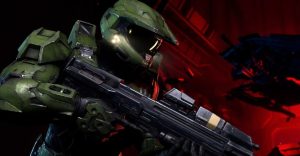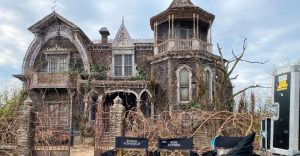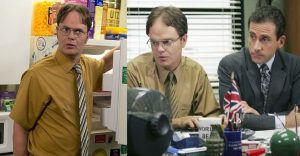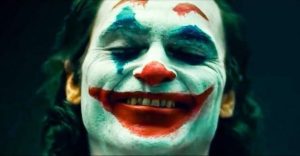Every Star Wars Easter Egg In The Bad Batch Episode 2
These are all of the Easter eggs from a more condensed installment of Star Wars: The Bad Batch. Order 66 has been carried out, and the Galactic Empire is taking root after Darth Sidious’ seismic proclamation, but as clone troopers across the galaxy fall helplessly in line with their programming, a small group of defectors are fighting back. Designed with specific mutations, the unique composition of Clone Force 99 meant Palpatine’s fateful order flew completely over the heads of Hunter, Wrecker, Tech, Echo, and Omega. Unfortunately, their sharp-shooting comrade Crosshair wasn’t so lucky, and now the Bad Batch are on the run.
The Bad Batch episode 2 takes our heroes to the remote locale of Saleucami, where they meet up with a familiar face from Star Wars: The Clone Wars. Navigating the increasingly tight grip of the Empire, Clone Force 99 get their new allies to safety, strengthening their own bonds in the process. By the end of “Cut & Run,” Hunter’s group remain high on Tarkin’s most wanted list, but the quintet have grown unquestionably closer as the next adventure beckons.
The Bad Batch‘s super-sized premiere episode was typically stuffed with Star Wars Easter eggs, many of which called back to The Clone Wars. Despite being a lighter affair, “Cut & Run” is similarly generous in its references, callbacks and allusions.
Saleucami

Virtually all of The Bad Batch‘s latest episode takes place on the Outer Rim planet of Saleucami. Although the setting has been used extensively within the “Legends” section of Star Wars canon, Saleucami had, until now, only officially been visited in Revenge of the Sith and Star Wars: The Clone Wars.
Beasts On Saleucami

As the Havoc Marauder lands on Saleucami, two distinct species of creature are seen running around the planet’s surface. The smaller, two-legged bullfrog type animals are known as Nuna, and are more commonly found on Naboo, having debuted in The Phantom Menace. The larger predator bullying them (and that later attacks Omega) is a Nexu.
Omega Is A More Talkative Grogu

Part Easter egg, part attempt to replicate past success, Omega’s story in “Cut & Run” closely mirrors that of Grogu’s in The Mandalorian. Just like Din Djarin, Hunter is a warrior who suddenly finds himself looking after a young child on the run from the Empire. Said child appears to be normal, but secretly harbors a latent inner power. Similar to how Djarin believed Grogu should be left in the care of Ahsoka Tano, Hunter decides to send Omega away with a “proper” family, but like her smaller, greener counterpart, she decides her place is alongside these roguish new guardians.
Omega Loves Dirt

Since birth, Omega has been restricted to the sterile, rainy environments of Kamino, but Saluecami offers a completely new landscape of natural vegetation, wild animals, and exotic plants. What really catches Omega’s attention, however, is good, old-fashioned dirt. Having never seen the stuff before, the youngster is captivated by the earthy soil beneath her feet – a fun inversion of Anakin Skywalker’s infamous hatred of sand. Has he tried dirt? Perhaps he’d prefer it. Sure, it gets everywhere, but it’s not as coarse.
“The Deserter”

As Clone Force 99 treks through the fields of Saleucami toward their mystery friend, Tech and Echo both refer to the character as a “deserter.” This would be a reference to Star Wars: The Clone Wars season 2’s “The Deserter,” which also took place on Saleucami and introduced the character of Cut Lawquane. In the same scene, Hunter claims Lawquane has been hiding from the Republic “for years.” The trooper-turned-farmer left his post following Attack of the Clones, meaning the period Hunter alludes to here is the time jump between Episode II and Revenge of the Sith.
“More Clones”

With Wrecker around, stealth is rarely Clone Force 99’s specialty, and after making a ruckus in the fields, the group are soon approach by Cut Lawquane and his Twi’lek wife, Suu. Unimpressed by the intrusion, Suu utters, “what do we have here… more clones who have lost their way?” This line calls back to the aforementioned The Clone Wars episode “The Deserter,” in which Jesse and Kix took an injured Captain Rex to the Lawquane farm. Suu confronted the three intruders, but after their true intentions were revealed, the Lawquanes gave the wandering clone trio permission to stay and recuperate. After Cut himself, then Captain Rex, Jesse and Kix, and now the Bad Batch, it’s hardly surprising that Suu is fed up with clones stumbling onto her land.
Cut Lawquane

The Lawquanes are a Star Wars Easter egg in themselves. Cut and Suu, along with their two children, Jek and Shaeeah, were all introduced in The Clone Wars season 2. Since Clone Force 99 wasn’t introduced until much later, it’s not clear how they’re so well acquainted with the Lawquane family (Uncle Wrecker!), but “Cut & Run” evidently isn’t their first visit. Another Cut Lawquane mystery raised in The Bad Batch‘s latest episode is how he managed to avoid Order 66. Has years of desertion rendered Cut’s inhibitor chip inert? Did Rex remove it? Was he too off-the-radar to receive Palpatine’s order? Or will he flip into attack mode at the merest glimpse of a Jedi?
Captain Rex

The Bad Batch’s connection to Cut Lawquane most likely comes from Captain Rex, their mutual friend, and this Star Wars: The Clone Wars and Star Wars Rebels character is mentioned throughout “Cut & Run.” According to Cut, Rex passed through the Saleucami farmstead shortly prior to the arrival of Hunter’s team. He informed them about Order 66 and the clone troopers murdering their Jedi generals, but left without specifying his destination. Since Rex is confirmed to appear in a future episode, the name-drop here sets up Clone Force 99 catching up with their pal before long.
Rex’s Inhibitor Chip

When Cut Lawquane informs the others of Rex’s status, he alludes to events that transpired in Star Wars: The Clone Wars season 7. During his off-screen visit, Rex apparently told Cut about the inhibitor chips forcing clone troopers to execute Order 66 without question, regardless of existing loyalties and friendships. Rex has this information because he succumbed to Palpatine’s instructions and attempted to kill Ahsoka Tano, but the Jedi was able to remove his inhibitor and restore Rex’s free will. These events happened concurrently with The Bad Batch‘s premiere.
The Oncoming Storm

Discussing their next move, Hunter and Cut speak of “the storm that’s coming” which, as understatements go, is fairly huge. The “storm” referenced here is the completion of the Empire’s takeover, and Palpatine’s tyrannical rule over the galaxy. His regime is currently still in its establishing phase, and the full devastation of the new galactic order won’t be felt for some years.
RGC-16 Speeder

As Hunter and Cut venture into the local town, Star Wars Easter eggs emerge from every corner. The first is a landspeeder screaming toward camera, and this is a model fans would’ve seen before. The RGC-16 appeared often throughout Star Wars: The Clone Wars, used on planets such as Lothal and Coruscant. In an additional Easter egg, The Bad Batch‘s speeder is painted to match the dusty orange of Luke Skywalker’s similar model in A New Hope.
Droids

Strolling through the streets of Saleucami, the market is predictably packed with an assortment of droids. Three different R-units can be spotted – one near the landspeeder that looks very much like R2-D2, an R5, and another darker R2 that raises the alarm after discovering Omega, only to receive a firm fist from Wrecker. Later in the episode, Wrecker is weight-lifting with a GNK droid back on the Havoc Marauder, much to the droid’s dismay. Another recognizable robot can be glimpsed ever so briefly at the Imperial-occupied port, pushing around some cargo. Identified by its Easter Island statue face design, this looks to be an 8D droid – a model that first appeared in Jabba’s palace during Return of the Jedi.
Alien Species

Just as Saleucami is full of familiar droid faces, eagle-eyed viewers will also spot a litany of different Star Wars races. Several Rodians are wandering around (the same species as Greedo), the shopkeeper is an Aleena, and a Snivvian is failing to board the ship leaving Saleucami without a chain code. A Bith (of Mos Eisley cantina band fame) is lurking in the background of town while the Lawquanes are queuing for passage, and walking alongside the R2-D2-esque droid is a Gotal. There are also Weequay, Felucians and a Balnab.
Chain Codes

“Cut & Run” takes place during a critical, albeit often overlooked, time in the Empire’s formation, where citizens were in the process of being stripped of their rights. Looking to escape Saleucami, Cut Lawquane suddenly discovers he needs a personal identification known as a chain code before he can travel off-planet. As a clone, this is very much a no-go, but Tech is able to live up to his name in time to save the day. This intrusive form of ID was first mentioned in The Mandalorian, by which point their usage has become a normal way of life, but in The Bad Batch‘s era, the concept is a shocking one.
Cut’s Credits Are No Good

When attempting to secure passage out of Saleucami, Cut Lawquane approaches a shady market trader, money jangling in-hand., but the seller replies with, “those credits won’t do you any good.” The onset of the Galactic Empire means a whole new currency, but the shopkeeper’s line itself is somewhat of a semi-regular Star Wars trope, where characters are told their credits are useless. The stingy saying can be traced back to Watto in The Phantom Menace, who told Qui-Gon Jinn that his Republic credits were no good on Tatooine.
Clones Having Names

Lamenting the overbearing nature of the new regime, Echo notes the irony of clones wanting to be addressed by names instead of numbers, only for chain codes to be introduced, assigning every citizen in the galaxy with a numerical designation. The concept of clones developing names has been seen previously in the Star Wars franchise, most notably in The Clone Wars, where names were inspired by each clone’s role, personality, or number. Echo, for example, was called such because he repeated orders and rules like an echo.
Wipe Cut Transition

George Lucas’ original Star Wars became famous for using wipe transitions to move from one part of the action to another. Due to the franchise’s immense popularity, the visual technique is now synonymous with the Star Wars “look” and The Bad Batch makes use of these wipes to switch between the Saleucami town and the Lawquane farm, for example.
Imperial Logos

In last week’s opening installment of The Bad Batch, a select few Galactic Republic logos were dotted around Kamino and elsewhere. Signifying the transition from Republic to Empire, the occupancy of Saleucami is littered with Imperial paraphernalia bearing the ominous new logo. Say what you like about Palpatine, but he knows how to rebrand.
Wrecker’s A True Stormtrooper After All

Hunter and Wrecker return to the Saleucami town with the Lawquane family in tow, planning to send them off to safety using forged chain codes. As the group enter shot from the right, Wrecker can be seen bashing his head against a low-hanging metal bar. It’s hard not to think of A New Hope‘s classic blooper, where a hapless Stormtrooper clangs his helmet against a blast door on the Death Star.
Old-School Access Ports

As Tech and Echo beaver away creating falsified credentials and trying to free the Havoc Marauder from its clamps, there’s plenty of plugging instruments into small ports. The design of these ports is regularly used throughout the Star Wars franchise, beginning with the very first film in 1977, when R2-D2 hacked into the Death Star and saved the day.
Passenger Ship

Escape from Imperial oppression in style and comfort with the Star Commuter 2000! The ship leaving Saleucami’s dock is a familiar vessel in Star Wars canon, having appeared before in both Star Wars Rebels and Star Wars Resistance. Although the vehicle is regularly used as a means of galactic public transport, the 2000’s inclusion in The Bad Batch is its earliest chronological credit.
About The Author

















